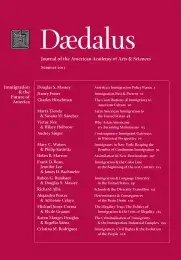Immigration & the Color Line at the Beginning of the 21st Century
The “color line” has long served as a metaphor for the starkness of black/white relations in the United States. Yet post-1965 increases in U.S. immigration have brought millions whose ethnoracial status seems neither black nor white, boosting ethnoracial diversity and potentially changing the color line. After reviewing past and current conceptualizations of America's racial divide(s), we ask what recent trends in intermarriage and multiracial identification – both indicators of ethnoracial boundary dissolution – reveal about ethnoracial color lines in today's immigrant America. We note that rises in intermarriage and multiracial identification have emerged more strongly among Asians and Latinos than blacks and in more diverse metropolitan areas. Moreover, these tendencies are larger than would be expected based solely on shifts in the relative sizes of ethnoracial groups, suggesting that immigration-generated diversity is associated with cultural change that is dissolving ethnoracial barriers – but more so for immigrant groups than blacks.
The “color line” has long served as a metaphor for the severe and enduring separation of whites and blacks in the United States. The election of Barack Obama to the U.S. presidency on November 4, 2008, however, broke a barrier many thought would never be breached. Yet while historic, this event’s significance for the color line remains unclear. If one recalls W.E.B. Du Bois’s famous and pessimistic prophecy from a century ago–that “the problem of the twentieth-century [would be] the problem of the color line”1–one might imagine that a single century would span too short a time to eradicate such a deeply entrenched barrier. Racial realists today, perhaps like Du Bois, may well view Obama’s election as merely indicating that an exceptionally talented and appealing individual who just happened to be black was fortunate enough to follow one of the most unpopular White House occupants in recent history. Though Obama ran a terrific campaign and became president of the United States, some analysts have thought the election alone . . .
